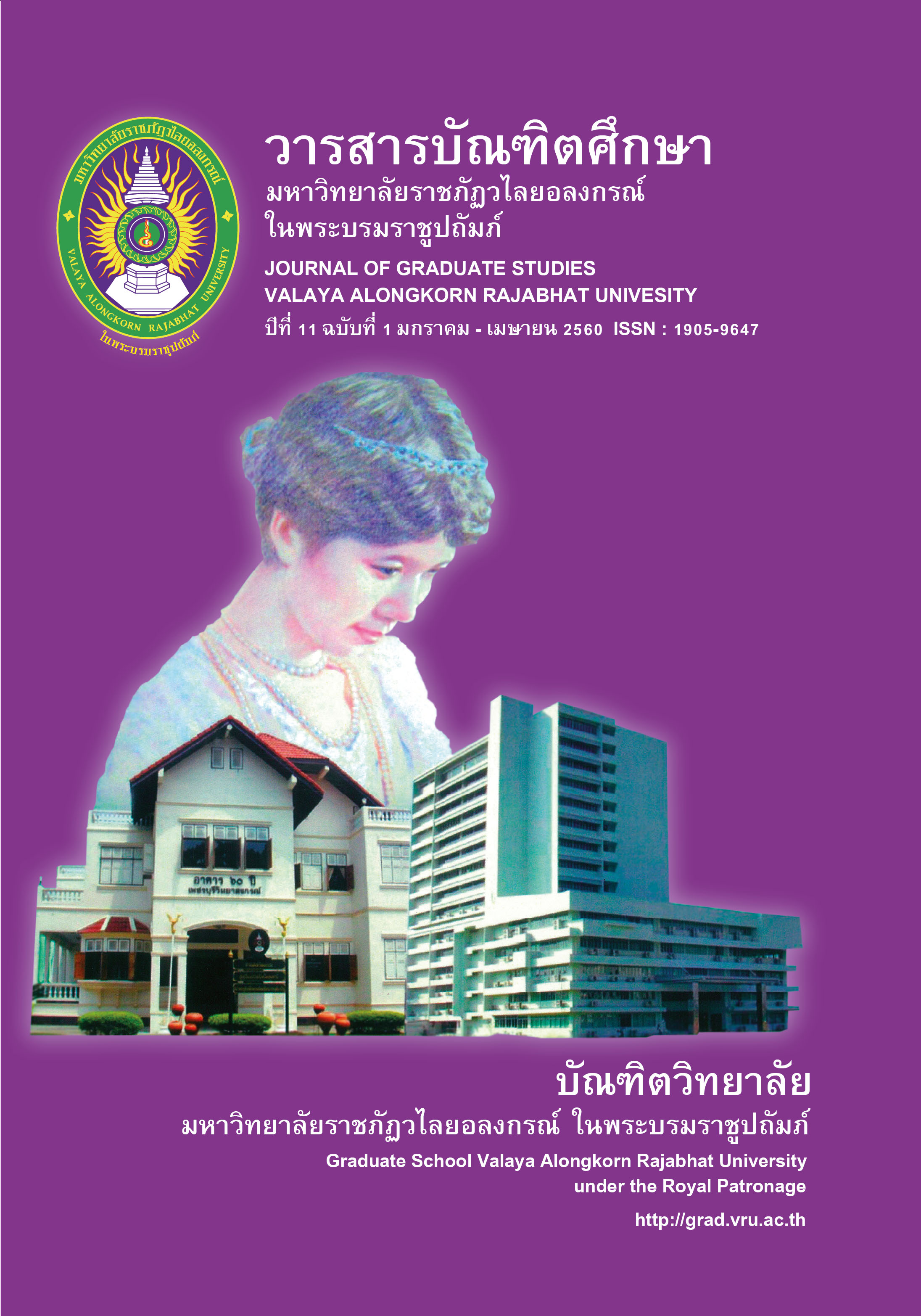การพัฒนารูปแบบการเรียนการสอนภาษาอังกฤษโดยใช้แนวคิดสมดุลภาษาสำหรับนักเรียนชั้นประถมศึกษาปีที่ 6
Main Article Content
Abstract
บทคัดย่อ
การวิจัยครั้งนี้มีวัตถุประสงค์เพื่อ 1) พัฒนารูปแบบการเรียนการสอนภาษาอังกฤษโดยใช้แนวคิดสมดุลภาษาสำหรับนักเรียนชั้นประถมศึกษาปีที่ 6 2) ศึกษาผลการใช้รูปแบบการเรียนการสอนภาษาอังกฤษโดยใช้แนวคิดสมดุลภาษาสำหรับนักเรียนชั้นประถมศึกษาปีที่ 6 และ 3) ศึกษาเจตคติต่อวิชาภาษาอังกฤษของนักเรียน กลุ่มตัวอย่างที่ใช้ในการทดลอง คือ นักเรียนชั้นประถมศึกษาปีที่ 6 โรงเรียนอนุบาลศรีวิไล จำนวน 53 คน โดยวิธีการสุ่มแบบกลุ่ม แบ่งเป็นกลุ่มทดลอง 22 คน กลุ่มควบคุม 31 คน เครื่องมือที่ใช้ในการทดลองคือ 1) แบบทดสอบ วัดผลสัมฤทธิ์ทางการเรียนรู้ภาษาอังกฤษ และ 2) แบบวัดเจตคติต่อวิชาภาษาอังกฤษ วิเคราะห์ข้อมูลทั้งเชิงปริมาณและเชิงคุณภาพ สถิติที่ใช้ในการวิเคราะห์ข้อมูล ได้แก่ ค่าเฉลี่ย ค่าเบี่ยงเบนมาตรฐาน ทดสอบความแตกต่างของค่าเฉลี่ยโดยใช้ Dependent Samples t-test และ Independent Samples t-test และ One Way ANCOVA ผลการวิจัยสรุปได้ดังนี้
1. รูปแบบการเรียนการสอนที่พัฒนาขึ้นมี 6 องค์ประกอบ ได้แก่ 1) แนวคิดทฤษฎีพื้นฐาน 2) หลักการ 3) วัตถุประสงค์ 4) เนื้อหา 5) กระบวนการเรียนการสอน และ 6) การวัดและประเมินผล โดยกระบวนการเรียนการสอนมี 5 ขั้นตอน ได้แก่ 1) ขั้นสาธิต 2) ขั้นเรียนรู้ 3) ขั้นฝึกทักษะ 4) ขั้นนำไปใช้ และ 5) ขั้นสรุปและประเมินผล
2. ผลการใช้รูปแบบการเรียนการสอนที่พัฒนาขึ้นสรุปได้ดังนี้
2.1 นักเรียนที่เรียนด้วยรูปแบบการเรียนการสอนภาษาอังกฤษโดยใช้แนวคิดสมดุลภาษามีผลสัมฤทธิ์ทางการเรียนหลังเรียนสูงกว่าก่อนเรียนอย่างมีนัยสำคัญทางสถิติที่ระดับ .01 และสูงกว่าผลสัมฤทธิ์ทางการเรียนหลังเรียนของนักเรียนที่เรียนด้วยวิธีปกติอย่างมีนัยสำคัญทางสถิติที่ระดับ .01
2.2 นักเรียนที่เรียนด้วยรูปแบบการเรียนการสอนภาษาอังกฤษโดยใช้แนวคิดสมดุลภาษามีเจตคติต่อวิชาภาษาอังกฤษหลังเรียนสูงกว่าก่อนเรียนอย่างมีนัยสำคัญทางสถิติที่ระดับ .01 และสูงกว่าเจตคติต่อวิชาภาษาอังกฤษหลังเรียนของนักเรียนที่เรียนด้วยวิธีปกติอย่างมีนัยสำคัญทางสถิติที่ระดับ .01
ABSTRACT
The purposes of this research were 1) to develop the English instructional model based on balanced approach for prathomsuksa 6 students 2) to examine the result of instructional model based on balanced approach for prathomsuksa 6 students and 3) to examine the student’s attitude towards English. The samples of this research were selected by using the cluster random sampling method, they were 53 prathomsuksa 6 students of Anuban Sriwilai School and they were subdivided into two groups 22 as the experimental group and 31 as the control group. The instruments of this research included 1) the achievement tests and 2) the questionnaires of the student’s attitude towards English. Both quantitative and qualitative data analysis approaches were employed for the experiment. Statistics used included mean, standard deviation, t-test for Dependent Samples, t-test for Independent Samples and One Way ANCOVA. The research findings were as follows:
1. The developed instructional model contained six components: 1) theory background, 2) principles, 3) objectives, 4) contents, 5) learning and teaching process and 6) assessment and evaluation. As for the learning and teaching process component, there were five stages in it: 1) demonstration, 2) learning, 3) practicing skills 4) applying knowledge and 5) summarizing and assessing.
2. The implementation of the developed instructional model can be summarized as follows.
2.1 The learning achievement of the students after learning through the English instructional model based on balanced approach were higher than before the experiment at the .01 level of significance and higher than the achievement after learning scores of the students who were taught through normal method at the .01 level of significance.
2.2 The attitudes of the students after learning through the English instructional model based on balanced approach were higher than before the experiment at the .01 level of significance and higher than the attitudes after learning scores of the students who were taught through normal method at the .01 level of significance.
Article Details

This work is licensed under a Creative Commons Attribution-NonCommercial-NoDerivatives 4.0 International License.
บทความทุกเรื่องได้รับการตรวจความถูกต้องทางวิชาการโดยผู้ทรงคุณวุฒิ ทรรศนะและข้อคิดเห็นในบทความ Journal of Global of Perspectives in Humanities and Social Sciences (J-GPHSS) มิใช่เป็นทรรศนะและความคิดของผู้จัดทำจึงมิใช่ความรับผิดชอบของบัณฑิตวิทยาลัย มหาวิทยาลัยราชภัฏวไลยอลงกรณ์ ในพระบรมราชูปถัมภ์ กองบรรณาธิการไม่สงวนสิทธิ์การคัดลอก แต่ให้อ้างอิงแหล่งที่มา


